‘Fiji: Art and Life in the Pacific’, which opens at the Sainsbury Centre at the University of East Anglia on 15 October, is unusual among exhibitions in Britain for its dedication to a particular place and people distant from the usual topics of art-historical and archaeological curation. The exhibition should be a revelation of fascinating works and art histories, otherwise familiar only to specialists. It will also enable fresh consideration of larger questions: how do curators do justice to cross-cultural art? What context should it be given? And what, more fundamentally, do we understand by ‘context’?
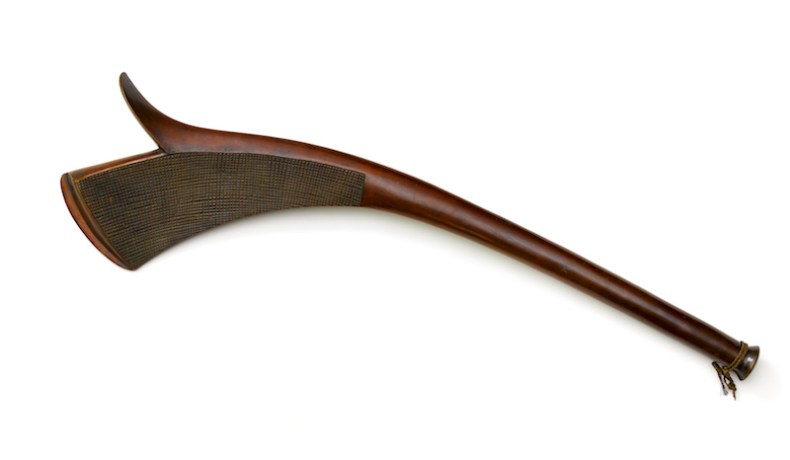
Club with flaring head form, 19th century, Fiji. Maidstone Museum and Bentlif Art Gallery, Kent
Globalisation is ubiquitously cited as the hallmark of our time, in financial journalism and contemporary art criticism alike, but major museums seem reluctant to diversify the focus of larger exhibitions accordingly. The British Museum has a distinguished record of smaller and medium-scale shows of African and Pacific textiles, Australian baskets, and a remarkable selection of Melanesian war shields, but bigger exhibits too often make safe bets on Egyptian mummies, Vikings, or similarly marketable subjects. On Great Russell Street, and elsewhere, the astonishingly rich reserve collections from West Africa, the Arctic and New Guinea, for example, are sampled (but scarcely) in permanent displays, rather than given the animation they deserve in question-raising, ideally provocative temporary exhibitions. Given the deep, if inevitably contentious, historic connections between Britain and many of these regions, and longstanding interests in acknowledging and affirming the diversity of migrant British identities, it’s perplexing that landmark exhibitions elsewhere, such as ‘Benin: Kings and Rituals’ (2007–08), ‘The Plains Indians: Artists of Earth and Sky’ (2014–15) and ‘Dance of the Ancestors: Art from the Sepik of Papua New Guinea’ (2015–16), have received prestigious showings at museums such as the Martin-Gropius-Bau, the Musée du quai Branly, the Metropolitan Museum of Art, and the Art Institute of Chicago, but failed to be taken up in the UK.

Man-shaped dish for Yaqona (kava), 19th century. Fiji Museum
Hence ‘Fiji’ represents an important and honourable exception, yet one that does not revive the classical anthropological idea of a traditional culture, bounded in space and time. Some 2,000 kilometres northeast of New Zealand, the Fijian archipelago, made up of over 100 inhabited islands as well as many more islets, was internally diverse and had, for many centuries, been in contact with neighbouring island groups including the Tongan and Samoan archipelagos. These relationships involved trade, intermarriage among aristocratic families, and conflict: this was a region with a deep and complex history of voyaging and interaction before Europeans appeared in the late 18th century. Once traders – from New England and New South Wales, seeking sandalwood among other islands commodities for Chinese and southeast Asian markets – began to enter the group, the resources they brought energised competition and conflict among Fiji’s chiefdoms. New materials, trade goods, and iron tools also led to much artistic innovation.
The Fiji exhibition features an extraordinary range of works and genres. Priests’ dishes, one in the form of a man, another in that of a duck, were repositories for an intense form of the indigenous narcotic drink kava, which shamans imbibed to take them into a trance. Mere vessels these are emphatically not. The bird’s extended wings suggest flight; the bulk of the man’s body relative to the head inverts the usual emphasis on the latter in Oceanic sculptures and masks, but nevertheless implies serenity, status and sanctity.
Heavy war clubs, avidly sought by some 19th-century collectors as exemplifications of Fijian savagery, bear intricate designs related to those of great painted barkcloths and tattoos. While such clubs were formidable and daunting as instruments of battle, they were much more than weapons; they were expressions of status and, as the complex patterns suggest, of symbolic resonance.

Model temple, 19th century, FIJI. Museum of Archaeology and Anthropology, Cambridge
Hundreds of metres of coconut-fibre cord form a finely-woven model shrine, a portable temple possibly taken by chiefs and their entourages on their frequent travels to trade, to initiate or sustain alliances, or to fight, among and beyond the South Pacific archipelago’s many islands. Whereas a basket woven from bleached and dyed pandanus fibre is animated by the play of geometry, by Oceanic optical art. If this could be seen less as a singular or high-status artefact than an everyday bag, something for a woman to carry her belongings around in, it’s still an extraordinary example of an ordinary thing.
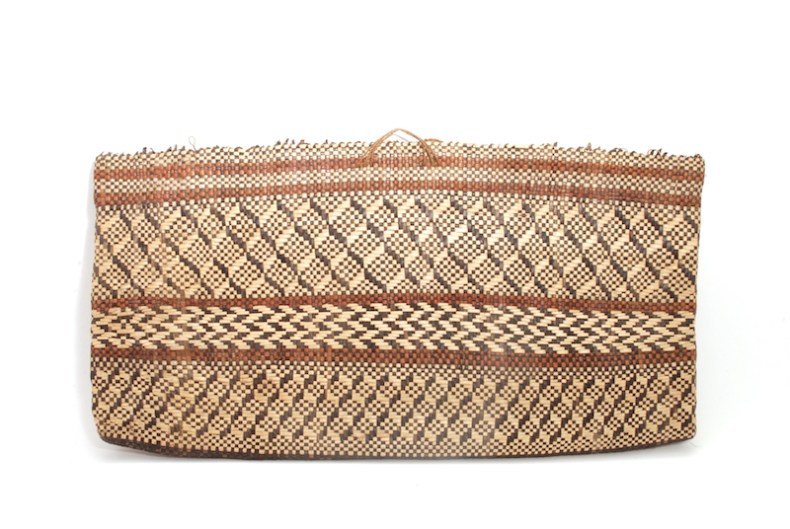
Plaited leaf basket, 19th century, Fiji. Museum of Archaeology and Anthropology, Cambridge
The exhibition, curated by the anthropologist Steven Hooper and colleagues, is the culmination of decades of research and is poised to reveal an extraordinary art tradition and a culture that remains alive and powerful in the present. This vitality is exemplified by the inclusion of an eight-metre-long sailing canoe made solely of wood, fibre and other traditional materials and fixings, which is the outcome of a project aiming to revive canoe construction in Fiji – part of a wider rediscovery of customary sailing, navigational techniques, craft and culture in Oceania.
Exhibitions of this kind have been dogged by a longstanding debate about ‘context’ that has been intermittently revived, in contradictory terms, over several decades. In the 1960s and ’70s, anthropologists well aware of the stimulus provided by African, Oceanic and native American works to various of the great 20th-century modernists objected to the treatment of these works as art, exemplified by the deliberate highlighting of aesthetics and form in the sparse displays typical of many north American art galleries. From this angle, exhibitions in ethnographic museums, which often included many more artefacts in any one vitrine, as well as photographs or moving images of landscapes, people or ceremonies, were considered not only more informative, but more progressive: they aspired to do justice to the original setting, and particularly to the cultural values salient to the works’ creators and local users. The aesthetic qualities of particular pieces were not necessarily ignored or negated, but gallery texts, audio guides and, more recently, multimedia and online resources encouraged visitors to understand the particular works shown in relation to culture, sociality, ritual and belief.
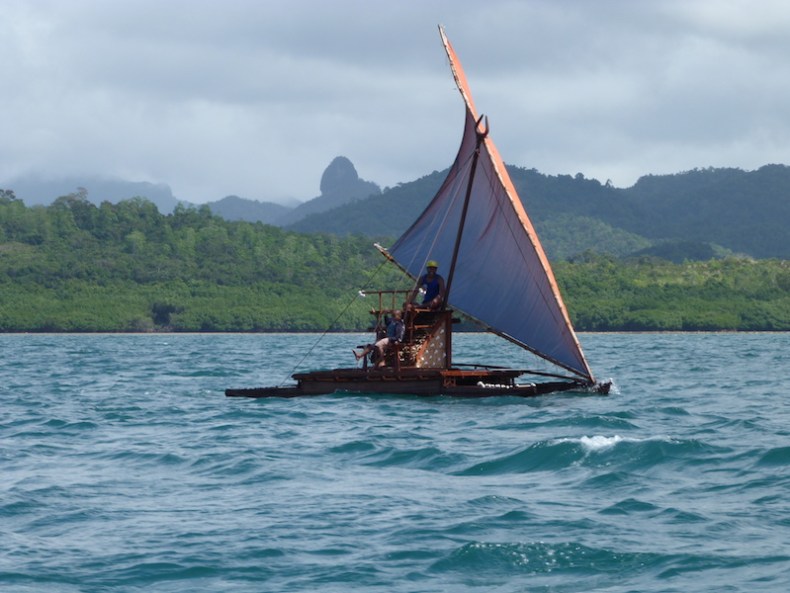
A specially commissioned eight-metre-long sailing canoe, made of wood and coir cord and similar to 19th-century vessels
Well-meaning as this project no doubt was, other perspectives have emerged in Britain and elsewhere, which lament the perceived sequestration of non-Western collections in ethnographic institutions, the reservation of the art museum for the West and modernity, and what’s seen as a pernicious relegation of black and minority-ethnic culture and communities to a separate, relatively devalued context. Although some Pacific and African artists have welcomed inclusion in anthropology museums, others see them as racist or residually racist and prefer their works to be shown only in an art setting.
These questions are often aired in theoretical terms, and appear intractable. In practice, curatorial approaches have moved on, and the supposed antinomies of art and ethnography are often transgressed. In Barcelona’s new Museu de Cultures del Món, a beautiful display of outstanding works from many cultures is underpinned by rich commentary and by old documentary film, of West African masquerade for example, presented like a video in a contemporary installation – as if not only ethnographic artefacts, but the work of ethnography itself, are appropriately seen as art.
What may be still more challenging is the task of unpicking what ‘context’ could possibly mean. There was and is much more to this, surely, than what an art perspective took away, and what an ethnographic or anthropological approach might restore. A wider and truly varied sense of context was evoked by the British Museum’s recent ‘Containing the divine’ exhibition, curated by Julie Adams. Although this had a single-object focus, it was nevertheless an important show, dedicated to one of the most famous of all Polynesian sculptures.
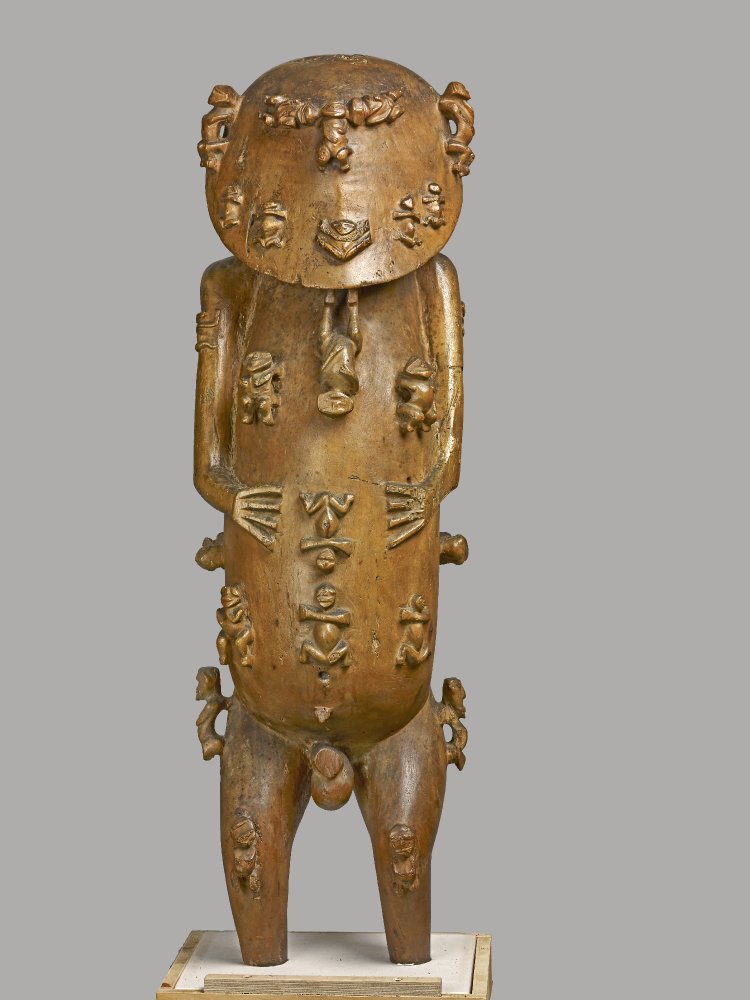
Standing casket figure (A’a), late 18th/early 19th century, Rurutu. British Museum, London
The figure of A’a, now known to be carved from scented sandalwood, is from Rurutu, some 570 kilometres south of Tahiti, part of the remote archipelago of the Austral Islands. The figure was made no later than the early 19th century, and may be much older. A’a is arresting for the proliferation of 30 smaller figures, some positioned to represent the eyes, nose and ears of the ancestor-god, others projecting from his chest, head, sides and knees. These, it has been suggested, exemplify a fractal relationship, the whole being imitated in a multiplicity of parts. But the postures and orientations of the figures are in fact notably different: the arms of some reach straight outwards, others have theirs folded across their chests, or feature one hand on the chest, and the other around the navel. These smaller figures may represent the god’s descendants, or exemplify his mana or spiritual power: other Polynesian art forms, such as the remarkable clubs from the Marquesas Islands known as ‘u’u likewise bear many faces within faces, implying an intensity of vision, knowledge and efficacy.
The sculpture constitutes a casket, the back forming a covering over a hollow body, said at the time of the work’s acquisition by the missionary John Williams in 1822 to have contained 24 smaller gods. Among the discoveries made in the course of technical investigations in the lead-up to the recent exhibition was a single red feather, caught on a splinter within the hollowed-out body. Across Polynesia, red was a sacred colour and red feathers were expressions of divinity, employed not to simply decorate but to empower. The understanding of customary Polynesian religion – relinquished in favour of Christianity in the 1820s – is speculative and challenging, hence we’ll never know precisely why A’a takes the extraordinary form that he does. There is a good chance that the figure was a mortuary casket of some kind, that like Maori and Marquean reliquaries it held the bones of a revered ancestor.
This ancestral context is but one of many that A’a has had over time. The work reached Europe, not because it was collected by a traveller in any standard fashion, but because it was presented by people from Rurutu, who had not been visited by any missionary, but encountered Williams in the course of a canoe voyage and formed their own interest in adopting Christianity – perhaps because Polynesians prior to European contact had created and embraced new cults from time to time. In due course they brought gods including A’a to him, which he understood as an act of surrender, a repudiation of ancestral paganism. While, in other times and places, Williams had encouraged or witnessed the burning of idols, on this occasion he was intrigued by the work, which was shipped back to England for display in London’s Missionary Museum: a trophy of evangelism. A’a played the part of rejected idol in a number of printed engravings, was at one time sent to Paris for a missionary exhibition there, then in 1890 was initially loaned, and subsequently formally transferred, to the British Museum, alongside the bulk of the missionary collection.
The figure was first cast to provide the missionary society with a substitute, but later for artists such as Picasso, who for a period had the work in his Cannes studio, and Henry Moore, who considered A’a so powerful that it was difficult to find anywhere in his house to put the work. William Empson wrote a famous poem, ‘Homage to the British Museum’, which took the awesome and bewildering figure as a bearer of ‘all the creeds of the world’ and an emblem of the Museum’s range over many civilisations; we should, Empson proposed, acknowledge ‘his reign over the entire building’. Islanders on Rurutu have remained well aware of A’a. A further cast was gifted to the people in the 1980s and has since been on display in the island’s Mairie. The god’s image is part of the island’s identity: one Rurutuan, Viriamu Teuruarii, who lives beside the marae or ritual precinct where the figure is believed to have been kept, has an image of the sculpture tattooed on to his chest.
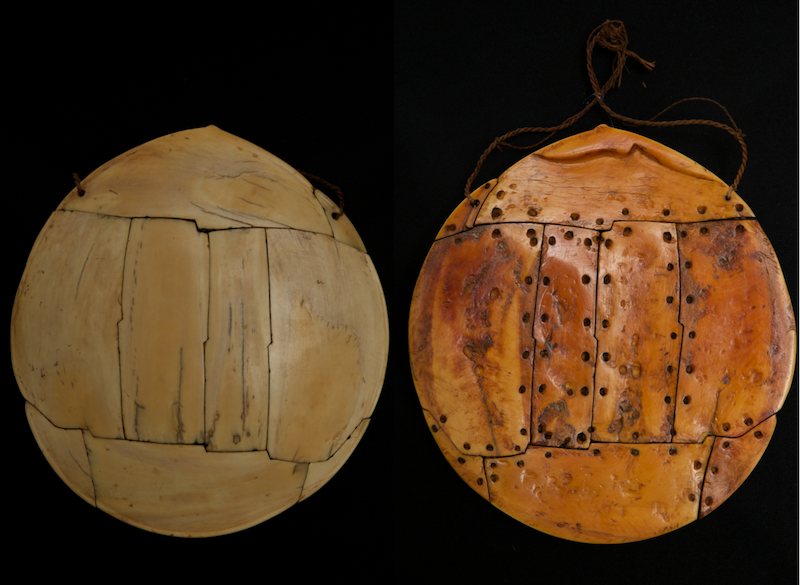
Breastplate (front and reverse), c. 19th century, Fiji. Fiji Museum
It is not unusual for famous works of art to have had many lives, hence many contexts. Audiences today are well aware that Shakespeare’s plays, especially those that centre on kingship, government and the morality of power, have animated audiences in seemingly contradictory ways over time. A’a is similarly a great and mysterious work that has affected communities of spectators in a plethora of ways. The god has not been a passive inhabitant of varied contexts, but something more like a living actor, who has made and animated context. The strength of the British Museum’s exhibition was not only its deft revelation of A’a’s probable original significance, insofar as that can be understood, and the sculpture’s subsequent roles – as star of missionary drama, as modernist art fetish, as synecdoche for the cross-civilisational edification the British Museum should stimulate – but also for its emphasis upon the interests of contemporary Rurutuans in the work. Some Pacific Islanders feel that curators do not recognise that the ‘artefacts’ they care for are in fact ancestors who, despite the many upheavals associated with religious change and colonisation, still bear spiritual power. Even for those who have never visited the Pacific or have little sense of Polynesian culture, that power can seem palpable. It perhaps underlay Moore’s feeling that A’a, even in reproduction, had such power that no place in his house was right for him.
In a less spectacular, but equally significant sense, many of the works to be included in ‘Fiji: Art and Life in the Pacific’ have undergone particular passages and stories that belie the notion that they had ‘a context’ in indigenous life, from which they were simply extracted. Those awesome Fijian weapons, beguiling kava dishes, and woven model spirit houses were traded to Europeans at a time of colonial pacification and the more or less reluctant adoption of Christianity by Fijians, which saw customary belief and its artistic expressions suppressed. In the mid 19th century, dazzling whale ivory and shell breastplates, ingeniously assembled, were expressions of the highest status and mana. In their time the most valuable things that Fijians knew, they were willingly gifted to early colonial governors and officials by chiefs concerned to consolidate relationships with powerful foreigners, indeed to draw those foreigners into their own longstanding relationships of sociality, indebtedness and mutual obligation.
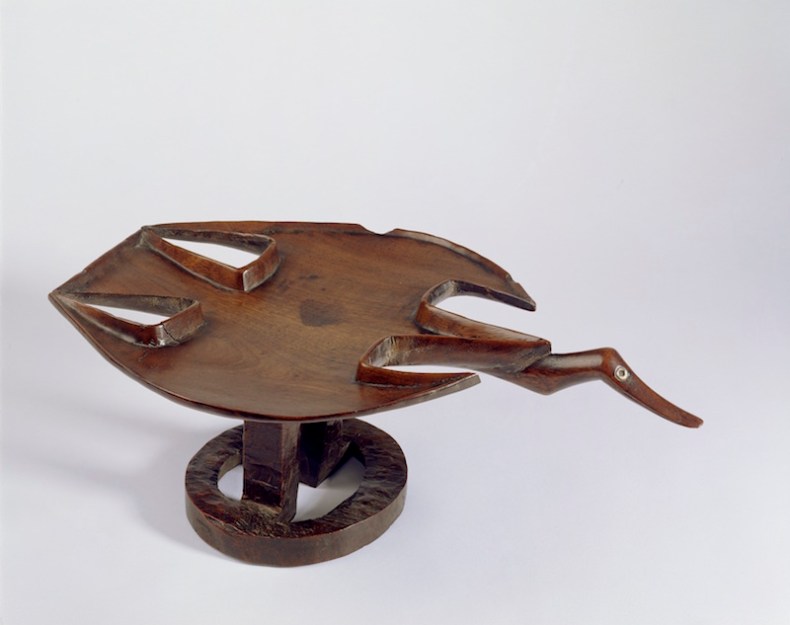
Duck-shaped dish for yaqona (kava), 19th century, Fiji. Sainsbury Centre, Nowrwich
The conventional notion of an object’s context presumes an artefact genre, rather than an individual work: a mask of a certain style is used in a particular ceremony, a headdress marks the identity of a shaman or the status of a leader. If a good many museum pieces may well belong in this sense to types, it’s striking that the more they are studied, the more collections appear replete with unique works of art. While A’a’s singularity stands out, the intricately engraved clubs made by artists from Fiji and neighbouring archipelagos turn out to be distinctive, inventive, quirky in their details – the example with the sculpted head from the British Museum is a unique creation. This suggests that the old opposition of art and ethnography was superseded from the start: like any other artists, indigenous makers were acting within a certain milieux, responsive to the demands and interests of their clients and communities, but also inclined to experiment.
Just as new investigations led to the discovery of A’a’s sacred feather, technical analysis has moreover demonstrated that some of the Fijian breastplates were made, altered and remade over time: their elements were so precious that they might be reused. These works do not, in fact, have contexts. Like people, they rather have had – and have ongoing – biographies. As they travel and grow older, they seem to act differently, bear and elicit more mature understandings, and affect people around them in unexpected and novel ways.
‘Fiji: Art and Life in the Pacific’ opens at the Sainsbury Centre at the University of East Anglia on 15 October and runs until 12 February 2017.
From the July/August issue of Apollo: preview and subscribe here
Unlimited access from just $16 every 3 months
Subscribe to get unlimited and exclusive access to the top art stories, interviews and exhibition reviews.

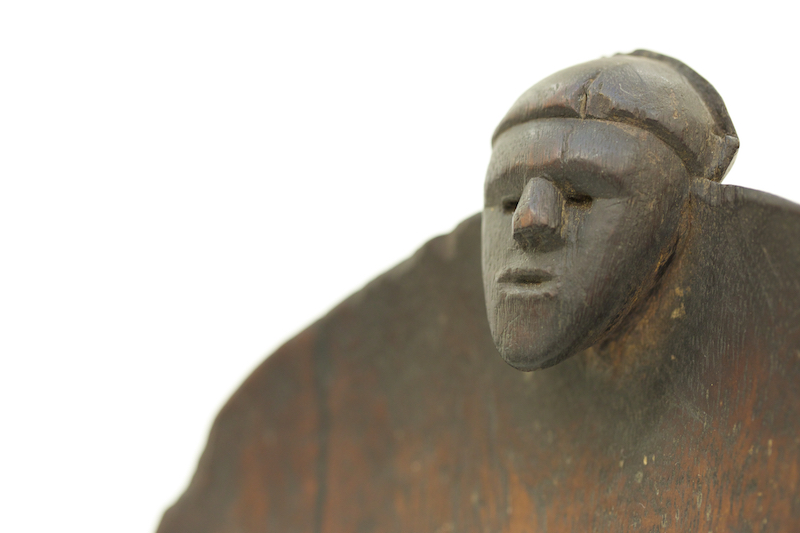
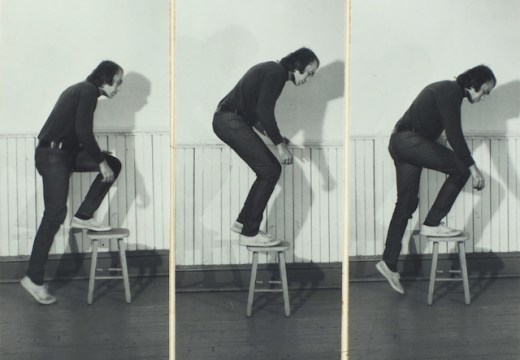

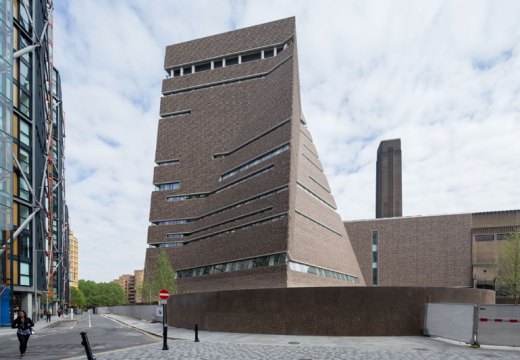









![Masterpiece [Re]discovery 2022. Photo: Ben Fisher Photography, courtesy of Masterpiece London](http://www.apollo-magazine.com/wp-content/uploads/2022/07/MPL2022_4263.jpg)
It’s time for the government of London to return to its rightful home